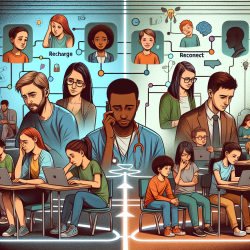Introduction
The COVID-19 pandemic has significantly impacted the mental health of children and college students. The research article "Mental Health Impact of COVID-19 among Children and College Students: A Systematic Review" provides a comprehensive overview of the mental health challenges faced by these groups during the pandemic. This blog aims to help practitioners improve their skills by implementing the outcomes of the research presented or by encouraging them to conduct further research.
Key Findings from the Research
The systematic review highlights that both children and college students have experienced increased levels of anxiety, depression, fatigue, and distress compared to pre-pandemic times. Several risk factors were identified:
- Living in rural areas
- Low family socioeconomic status
- Being a family member or friend to a healthcare worker
These factors were strongly associated with worse mental health outcomes.
Implications for Practitioners
Practitioners can take several steps to address the mental health challenges highlighted in the research:
- Implement Early Childhood Mental Health Consultation (ECMHC): This preventative intervention places mental health consultants in early childcare settings, addressing children's individual needs and increasing their social and emotional health.
- Expand Telehealth Services: With the rise of telehealth, practitioners should explore ways to provide mental health support to children and college students, especially those in rural areas or with limited access to in-person services.
- Address Socioeconomic Disparities: Develop programs that provide resources and support to families with low socioeconomic status, ensuring children have access to necessary academic and technological resources.
- Support for Families of Healthcare Workers: Provide targeted mental health services to families and friends of healthcare workers, who may experience increased anxiety due to their close contact with the virus.
Encouraging Further Research
The research identifies several gaps that practitioners and researchers should address:
- Conduct interventional studies to evaluate the direct impacts of mental health treatment or preventive measures on mental illnesses.
- Focus on nationally or regionally representative studies to apply findings to broader populations.
- Conduct longitudinal cohort studies to identify potential changes in mental health outcomes over time.
- Assess additional mental health variables, such as suicide ideation, insomnia, coping, and quality of life.
Conclusion
Understanding the mental health impact of COVID-19 on children and college students is crucial for creating effective interventions. Practitioners should implement strategies based on the research findings to support the mental well-being of these groups. By addressing the identified risk factors and encouraging further research, we can better prepare for future challenges and improve mental health outcomes.
To read the original research paper, please follow this link: Mental Health Impact of COVID-19 among Children and College Students: A Systematic Review










